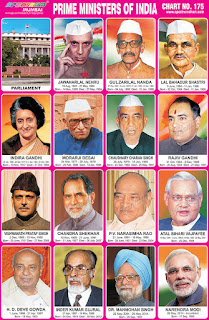Parliament - Sansad
Bhawan (Parliament Building) is the house of the Parliament of India,
located in New Delhi. Construction of
parliament house began in 1921. The opening ceremony of the
Parliament House was performed on 18 January 1927 by Lord Irwin, the
then Viceroy of India.
Jawaharlal Nehru -
Jawaharlal Nehru was the first Prime Minister of India and a central
figure in Indian politics before and after independence. He emerged
as the paramount leader of the Indian independence movement under
the tutelage of Mahatma Gandhi and ruled India from its
establishment as an independent nation in 1947 until his death in
1964.
Gulzarilal Nanda -
Gulzarilal Nanda was an Indian politician and economist who
specialised in labour issues. He was the Prime Minister of India for
two short periods following the deaths of Jawaharlal Nehru in 1964
and Lal Bahadur Shastri in 1966. He was awarded the Bharat Ratna,
India's highest civilian award, in 1997.
Lal Bahadur Shastri - Lal
Bahadur Shastri was the second Prime Minister of independent India.
He was a man of great courage and will. He successfully led country
during the 1965 war with Pakistan.
Indira Gandhi - Indira
Gandhi was a key 20th century stateswoman, a central figure of the
Indian National Congress party and to date the only female Prime
Minister of India. She served as Prime Minister from 1966 to 1977
and then again from 1980 until her assassination in 1984.
Morarji Desai - Morarji
Desai was a Prime Minister of India from 1977 to 1979. He was also
the first Prime Minister to head India's first non-Congress
Government. Desai was the only Indian national to be conferred with
Pakistan's highest civilian award, Nishan-e-Pakistan.
Chaudhary Charan Singh -
Chaudhary Charan Singh was the Prime Minister of the Republic of
India, serving from July 1979 until January 1980. Chaudhary Charan
Singh's government did not face the Lok Sabha during his brief
tenure as the Congress party withdrew their support from his
Government. Before being prime minister he also served as a chief
minister of Uttar Pradesh.
Rajiv Gandhi - Rajiv Gandhi
was the Prime Minister of India, serving from 1984 to 1989. He took
office after the 1984 assassination of his mother, Prime Minister
Indira Gandhi, to become the youngest Indian Prime Minister. He was
assassinated by a suicide bomber from the LTTE in 1991. In 1991 the
Indian government posthumously awarded Gandhi the Bharat Ratna, the
country's highest civilian award.
Vishwanath Pratap Singh -
Vishwanath Pratap Singh, Indian politician and government official
was the Prime Minister of India for slightly less than a year, from
December 1989 to November 1990. He is known for trying to improve
the lot of India's lower castes as a Prime Minister. Singh was
renowned for his obsession with honesty and his willingness to
sacrifice office.
Chandra Shekhar - Chandra
Shekhar Singh was an Indian politician who served as the 8th
Prime Minister of India from November 1990 to June 1991. Chandra
Shekhar was prime minister for seven months, the second shortest
period after that of Charan Singh.
P. V. Narasimha Rao -
Pamulaparti Venkata Narasimha Rao was an Indian lawyer and
politician who served as the Prime Minister of India from 1991
to 1996. He led an important administration, overseeing a major
economic transformation. He is often referred to as the "Father
of Indian Economic Reforms".
Atal Bihari Vajpayee - Atal
Bihari Vajpayee is an Indian statesman who was the 10th
Prime Minister of India. Vajpayee was a parliamentarian for over
four decades. Atal Bihari Vajpayee was honoured with the Bharat
Ratna award, India's highest civilian honour.
H. D. Deve Gowda -
Haradanahalli Doddegowda Deve Gowda is an Indian politician who was
the 12th Prime Minister of India from June 1996 to April
1997. Previously he was the 14th Chief Minister of
Karnataka from 1994 to 1996.
Inder Kumar Gujral - Inder
Kumar Gujral was an Indian politician who served as the Prime
Minister of India for a period less than a year, from April 1997 to
March 1998. He is known for the 'Gujral Doctrine', which emphasises
the importance of friendly and warm relations with India's
neighbours.
Dr. Manmohan Singh – Dr.
Manmohan Singh is an Indian economist and politician who served as
the Prime Minister of India from 2004 to 2014. He was also the first
prime minister since Jawaharlal Nehru to be re-elected after
completing a full five-year term. Before sworn in as prime minister
he held several key posts in the Government of India, such as Chief
Economic Advisor (1972–76), Reserve Bank governor (1982–85) and
Planning Commission head (1985-87), Finance Minister (1991-96).
Narendra Modi - Narendra
Modi is the 15th and current Prime Minister of India, in office
since 26 May 2014. Prime Minister Modi focused on reforming and
modernising India's infrastructure, reducing bureaucracy,
encouraging increased foreign direct investment, improving national
standards of health and sanitation and improving foreign relations.
He also served as a Chief Minister of Gujarat from 2001-14, where
his economic policies have been praised worldwide.


No comments:
Post a Comment